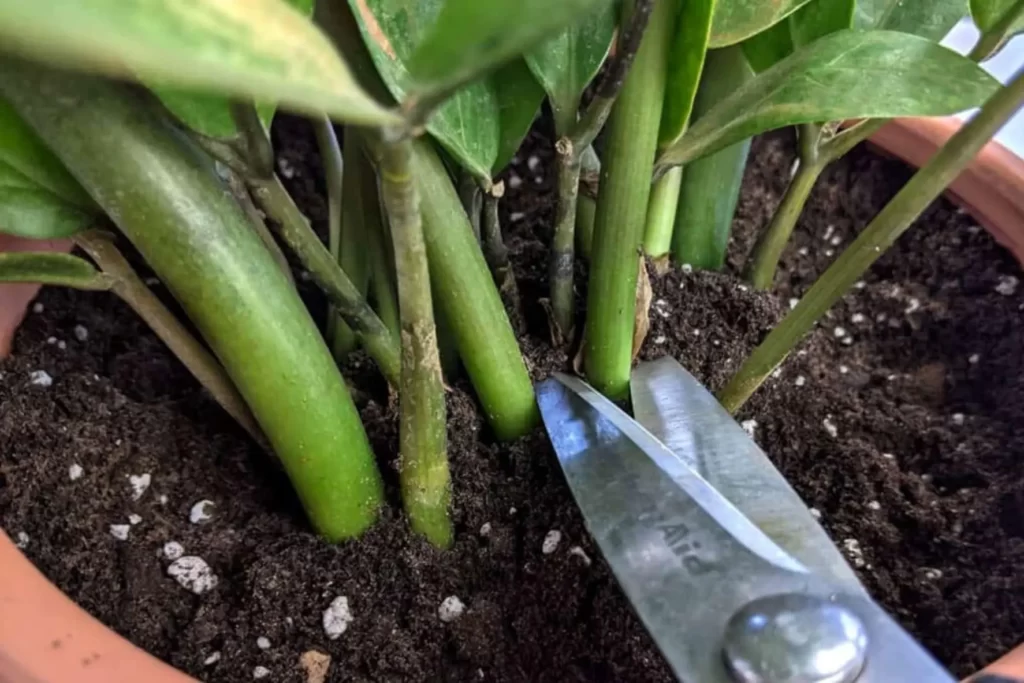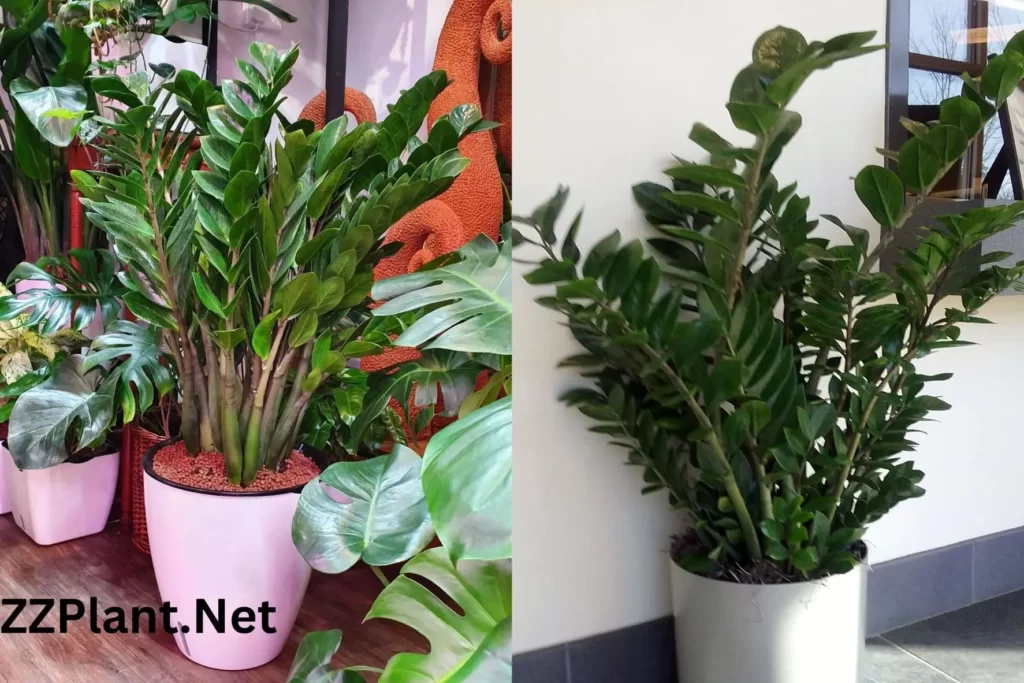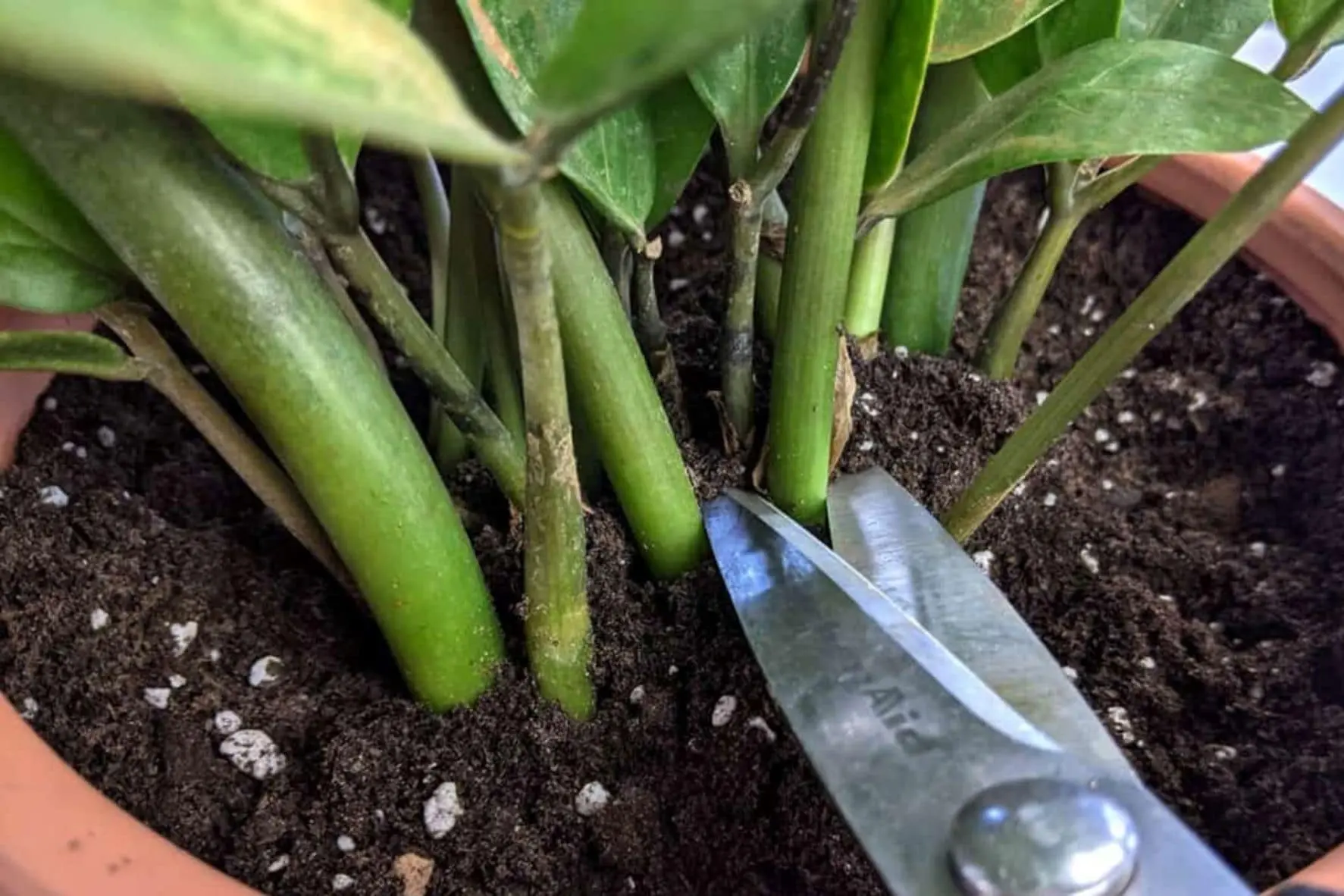The ZZ plant, also known as Zamioculcas zamiifolia, is a popular houseplant known for its low maintenance and ability to thrive in low light conditions.
However, just like any other plant, regular pruning is essential for its growth and overall health.
In this guide, we will discuss everything you need to know about pruning your ZZ plant, including when to prune, how to prune, and what to do with the pruned leaves.
When to Prune
The best time to prune a ZZ plant is in the spring or early summer, as this is when the plant is most actively growing.
During this time, the plant will have the energy and resources to quickly recover and grow new leaves.
However, it is important to note that ZZ plants can tolerate pruning at any time of the year, so if you have missed the active growing season, don’t worry – your plant will still be fine.

How to Prune
When pruning your ZZ plant, it is important to use clean, sharp scissors or pruning shears. This will ensure a clean cut and prevent any damage to the plant.
- Start by removing any yellow or brown leaves. These leaves are no longer providing any benefits to the plant and are only taking away resources.
- Next, remove any leaves that are growing too close to the main stem of the plant. These leaves can cause the stem to bend or even break, so it is important to remove them.
- If your ZZ plant is getting too tall or leggy, you can also trim the top of the plant to encourage branching.
- Finally, give the plant a general shape by removing any leaves that are growing out of place or are too long.
What to Do with Pruned Leaves
After pruning your ZZ plant, you may be wondering what to do with the removed leaves. One option is to dispose of them in the trash.
However, if you want to be more environmentally friendly, you can compost them. Just be sure to remove any brown or yellow leaves before adding them to the compost pile, as they can attract pests.
Importance of Pruning
Pruning is an essential part of plant maintenance and plays a vital role in promoting the overall health and growth of the plant. Some of the key benefits of pruning include:
1. Encourages bushier growth

When it comes to pruning, encouraging bushier growth is a key goal. This can be achieved through a technique known as “pinching” or “tip pruning”.
Pinching involves removing the tips of the plant’s branches, which encourages the growth of new branches at the point of the pinch. This results in a bushier plant with more foliage and a more full appearance.
To pinch a ZZ plant, use sharp, clean scissors or pruning shears to snip off the tips of the branches, leaving about 1/4 to 1/2 inch of the stem. Be sure to make the cut just above a leaf node, which is the point on the stem where a new leaf or branch will grow.
It’s important to note that pruning should be done at the right time and in the right way to avoid any damage to the plant. The best time to prune a ZZ plant is in the spring or early summer, as this is when the plant is most actively growing.
Avoid pruning during the dormant period, which is in the fall and winter.
It’s also important to avoid over-pruning, as this can harm the plant and slow down its growth. Start by pruning just a few branches at a time, and wait to see the results before pruning more. This will allow you to gauge the plant’s response and make adjustments as needed.
Regularly pruning your ZZ plant will encourage bushier growth and improve its overall health and appearance. By following the right technique, timing and not overdoing it, you’ll be able to maintain a beautiful and healthy ZZ plant.
2. Improves plant shape

Pruning is an effective way to shape and maintain the desired form of a plant, including a ZZ plant. The process of shaping a plant through pruning is known as “hedging” or “topiary”. It involves removing unwanted or excess branches, leaves and stems to create a specific shape or form.
To shape a ZZ plant, use sharp, clean scissors or pruning shears to snip off the branches, leaves, and stem. The process involves removing unwanted or excess branches, leaves, and stems to create a specific shape or form. It’s important to make sure that the cuts are clean and precise to avoid damaging the plant.
When shaping a ZZ plant, it’s important to consider the plant’s natural growth habits. ZZ plants tend to grow tall and narrow, so pruning can be used to control their height and width.
To keep the plant compact and bushy, pinch the tips of the branches and remove any leggy or overcrowded growth. If you want the plant to grow taller, allow the top branches to grow, but be sure to remove any side branches that are competing for light and space.
You can also use pruning to create a specific shape, such as a globe or spiral shape. To create a globe shape, pinch the tips of the branches to encourage bushier growth and then remove any branches that are growing too tall or too wide.
To create a spiral shape, allow the top branches to grow taller and then wrap them around a support to create the spiral shape.
3. Increases flowering

Pruning can also be used to increase flowering in a ZZ plant, although it’s not a common practice as ZZ plant is not a flowering plant. ZZ plants are known for their glossy, dark green leaves and they do not produce flowers.
However, if you want to encourage more growth, pruning is still a good idea. As previously mentioned, pruning can encourage bushier growth and improve the overall health and appearance of the plant.
By removing any damaged, diseased or overcrowded branches, the plant will be able to direct more energy towards healthy growth, including the development of new leaves.
In summary, while pruning doesn’t directly increase flowering in ZZ plants, it can still be beneficial in encouraging bushier growth, improve the overall shape and health of the plant.
By following the right technique, timing and not overdoing it, you’ll be able to maintain a beautiful and healthy ZZ plant.
4. Enhances air circulation and sunlight penetration
Pruning can also be used to enhance air circulation and sunlight penetration in a ZZ plant. Good air circulation and sunlight penetration are important for the health and growth of any plant, including a ZZ plant.
Air circulation helps to reduce the humidity levels around the plant, which can prevent the growth of mold and mildew.
It also helps to dry out any wet or damp areas, which can prevent the spread of disease. Good air circulation also helps to reduce the risk of pests, as it makes it harder for them to establish themselves on the plant.
Sunlight penetration, on the other hand, is essential for the photosynthesis process, which is how the plant produces food. The more sunlight that a plant receives, the more energy it has to grow and thrive.
By pruning your ZZ plant, you can enhance air circulation and sunlight penetration. This can be done by removing any overcrowded or leggy growth that is blocking the light and air from reaching the plant’s interior.
It’s also important to prune any branches that are growing too tall or too wide, as this can prevent the light and air from reaching the lower leaves. This can help to promote bushier growth and a more compact plant shape.
Another way to enhance air circulation and sunlight penetration is by removing any damaged or diseased branches. This will help to prevent the spread of disease and pests and promote healthy growth.
5. Reduces pests and diseases
Pruning can also be used to reduce pests and diseases in a ZZ plant. By removing any damaged, diseased or overcrowded branches, the plant will be less likely to attract pests and diseases.
One of the ways that pruning can help to reduce pests and diseases is by enhancing air circulation and sunlight penetration, as mentioned earlier.
Good air circulation and sunlight penetration can help to dry out any wet or damp areas, which can prevent the growth of mold and mildew.
Another way that pruning can help to reduce pests and diseases is by removing any branches that are showing signs of damage or disease.
This can help to prevent the spread of disease and pests to other parts of the plant. It’s important to remove any branches that are showing signs of damage or disease as soon as possible, as this will help to minimize the impact on the plant.
It’s also important to sterilize your pruning tools before and after pruning to prevent the spread of disease from one plant to another. This can be done by wiping the blades with a solution of water and bleach or rubbing alcohol.
6. Increases the lifespan
Pruning can also be used to increase the lifespan of a ZZ plant. By removing any damaged, diseased or overcrowded branches, the plant will be less likely to attract pests and diseases, which can shorten the plant’s lifespan.
Removing dead, damaged, or diseased branches can also help to improve the overall health and appearance of the plant, making it more attractive and increasing its lifespan.
Pruning can also help to promote bushier growth and a more compact plant shape, which can make the plant look fuller and healthier, and increase its lifespan.
Another way that pruning can help to increase the lifespan of a ZZ plant is by removing any branches that are growing too tall or too wide. This can help to prevent the plant from becoming too leggy and top-heavy, which can make it more susceptible to damage or disease.
It’s also important to prune any branches that are growing too close together, as this can prevent the light and air from reaching the lower leaves, which can cause them to yellow and die, shortening the plant’s lifespan.
FAQs:
The amount of pruning will depend on the size and condition of your plant. As a general rule, it’s best to remove no more than one-third of the plant’s foliage at one time.
Yes, you can propagate your ZZ plant by pruning. Take stem cuttings that are at least 3 inches long and remove the lower leaves. Allow the cutting to dry for a day or two before sticking it in soil. Keep the soil moist and in bright indirect light until roots are established.
You can sterilize your pruning tools by wiping the blades with a solution of water and bleach or rubbing alcohol before and after pruning. This will help to prevent the spread of disease from one plant to another.
If done correctly and at the right time, pruning should not harm your ZZ plant. However, if done incorrectly, or if too much is removed at one time, it can damage or kill the plant. It’s important to follow proper pruning techniques and to only remove a small amount of foliage at one time.
Conclusion
Pruning your ZZ plant is an essential part of its overall health and growth. By following these tips on when, how, and what to do with the pruned leaves, you will be able to keep your ZZ plant looking its best.
Remember to always use clean, sharp tools and to be mindful of the plant’s active growing season. Happy pruning!

